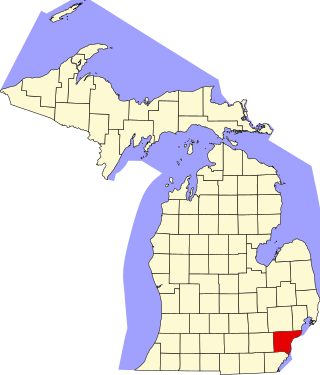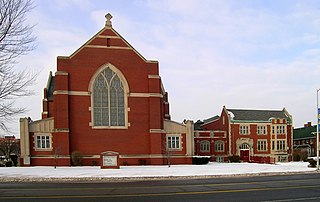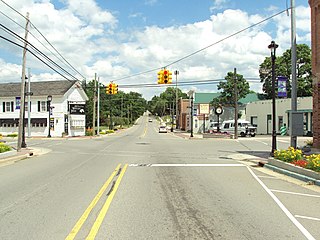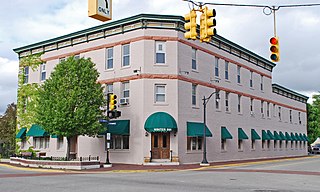
Greenville is a city in Montcalm County of the U.S. state of Michigan. The population was 8,816 at the 2020 census.

This is a list of the National Register of Historic Places listings in Wayne County, Michigan.

The St. John's Christian Methodist Episcopal Church is a church located in Detroit, Michigan. It was built as the North Woodward Congregational Church, listed on the National Register of Historic Places in 1982, and designated a Michigan State Historic Site in 1998.

This is a list of the National Register of Historic Places listings in Detroit, Michigan.

The Cass Park Historic District is a historic district in Midtown Detroit, Michigan, consisting of 25 buildings along the streets of Temple, Ledyard, and 2nd, surrounding Cass Park. It was listed on the National Register of Historic Places in 2005 and designated a city of Detroit historic district in 2016.

The Jefferson–Chalmers Historic Business District is a neighborhood located on East Jefferson Avenue between Eastlawn Street and Alter Road in Detroit, Michigan. The district is the only continuously intact commercial district remaining along East Jefferson Avenue, and was listed on the National Register of Historic Places in 2004.
Bergen-Lafayette is a section of Jersey City, New Jersey.

The University–Cultural Center MRA is a pair of multiple property submissions to the National Register of Historic Places which were approved on April 29 and May 1, 1986. The structures included are all located in Midtown, near Woodward Avenue and Wayne State University in Detroit, Michigan. The two submissions are designated the University–Cultural Center MRA Phase I, containing five properties, and the University–Cultural Center MRA Phase II, containing three properties.

The Metamora Crossroads Historic District is a historic district centered at the intersection of Oak and High Street in the small village of Metamora in Metamora Township in Lapeer County, Michigan. It was designated as a Michigan State Historic Site and also added to the National Register of Historic Places on July 19, 1984.

The Iron County MRA is a Multiple Resource Area addition to the National Register of Historic Places, which includes 72 separate structures and historic districts within Iron County, Michigan, United States of America. These properties were identified and placed on the Register in 1983, with the exception of one property that was placed on the Register in 1993.

The Chelsea Commercial Historic District is a historic district located along both sides of Main Street from Orchard to North Street in Chelsea, Michigan; the district also includes the adjacent 100 blocks of Jackson, East Middle, and West Middle Streets, as well as structures on Park, East, and Orchard Streets. It was listed on the National Register of Historic Places in 2011.

The Main Street Historic District is a commercial historic district that includes structures located at 3-153 East Main Street, 1-41 West Main Street, and 8 Park Lane in Milan, Michigan. Although within Milan, the district spans the county line between Washtenaw County, Michigan and Monroe County, Michigan, containing structures within both counties. It was listed on the National Register of Historic Places in 1999.

The Winter Inn is a hotel located at 100 N. Lafayette Street in Greenville, Michigan. It was designated a Michigan State Historic Site in 1979 and listed on the National Register of Historic Places in 1980. The building is significant as a still-functioning example of a modest, locally owned hotel of a type once common in small towns like Greenville.

The Alma Downtown Historic District is a commercial historic district in Alma, Michigan, roughly located along Superior Street between the Pine River and Prospect Avenue, and along State Street between Center and Downie Streets. Parts of the district were designated a Michigan State Historic Site in 1975, and the entirety was listed on the National Register of Historic Places in 2013. It contains 72 structures, primarily brick commercial buildings, ranging from one to three stories in height and dating from 1874 to the 1960s.

The Iron Mountain Central Historic District is a historic district, broadly located between Fleshiem and C Streets and between Iron Mountain and Stockbridge Avenues in Iron Mountain, Michigan. The district covers the city's central business district and adjacent areas. It is primarily commercial, but also contains the historic county courthouse complex, and school, library, and church buildings. It was listed on the National Register of Historic Places in 2013.

The Clare Downtown Historic District is a collection of 51 buildings located along four blocks of North McEwan Street in Clare, Michigan, along with adjacent portions of East and West Fourth Street and East and West Fifth Street. Street addresses of the structures run from 307 to 622 North McEwan, 114-120 East Fifth Street, 102-202 West Fifth Street, 112-115 East Fourth Street, and 112-124 West Fourth Street. The district was listed on the National Register of Historic Places in 2016.

The Center Avenue Neighborhood Residential District is a residential historic district located in Bay City, Michigan, running primarily along Center, Fifth, and Sixth Avenues between Monroe and Green Avenues, with additional portions of the district along Fourth between Madison and Johnson, down to Tenth Avenue between Madison and Lincoln, along Green to Ridge, and around Carroll Park. The original section, along Center and portions of Fifth and Sixth, was listed on the National Register of Historic Places in 1982. A boundary increase including the other sections of the neighborhood was listed in 2012.

The Van Buren Street Historic District is a cultural historic district located roughly along Van Buren Street from Capital and Cherry Streets to Calhoun Street and North Avenue in Battle Creek, Michigan. It was listed on the National Register of Historic Places in 1996.

The Charlotte Central Historic District is a mixed commercial, residential, and historic district located in the downtown section of Charlotte, Michigan. The district stretches along Cochran Avenue from West McClure Street to south of Henry Street, containing portions of the streets adjacent to Cochran. It was listed on the National Register of Historic Places in 2020.

The Sault Ste. Marie Historic Commercial District is a primarily commercial historic district located in Sault Ste. Marie, Michigan. It was listed on the National Register of Historic Places in 2020. The district includes the Old Federal Building, Chippewa County Courthouse, Central Methodist Episcopal Church, the Adams Building, and the Gowan Block, all of which are listed separately on the National Register.

























